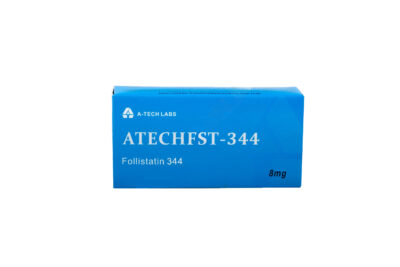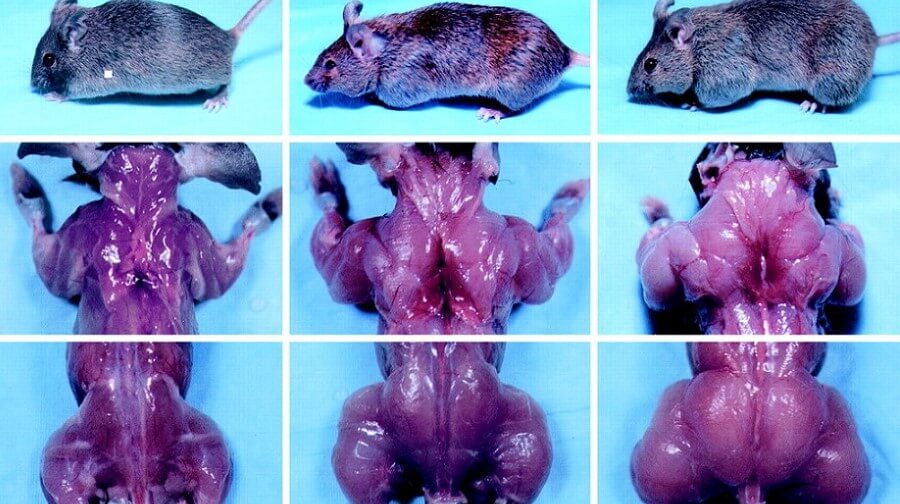 Formerly known as Growth differentiation factor 8 (GDF 8), myostatin limits muscle tissue growth. It’s a member of the TGF Beta 1 protein family.
Formerly known as Growth differentiation factor 8 (GDF 8), myostatin limits muscle tissue growth. It’s a member of the TGF Beta 1 protein family.
It’s a protein that directly impacts growth by acting on muscle fibers. Therefore myostatin is also found in the muscle cells.
If the amount of myostatin is too low, the muscles will develop too much. On the other hand, if there is too much myostatin in the body, muscle mass will be insufficient. This is the case for people suffering from heart failure: the heart contains too much myostatin.
This protein is present in the striated muscle cells of skeletal muscle.
People lacking this protein suffer total muscular hypertrophy like athletes practicing intense bodybuilding.In the event of excess myostatin in the body, the person or animal will suffer slowed muscle development.
Regular exercise can definitively decrease levels of this protein in the body, both in the skeletal muscle and the heart.
Several studies have been conducted on naturally regulating muscle growth with the protein myostatin in the hopes of finding a way to block its action in order to increase muscle mass in humans or animals.
Muscular hypertrophy caused by myostatin trouble is due to the mutation of the GDF8 gene found in chromosome 2.
Increased muscle size does not necessarily come with the increase in muscle strength that should naturally accompany it. The fatty tissue connected to the muscle is not generally thick.
Homozygous and heterozygous carriers have the same medical signs, which depend solely on the amount of myostatin. Homozygous carriers have muscles double the normal volume.
Follistatin
Follistatin is a protein. It helps regulate growth factors in TGF beta family, mainly influencing activins and inhibins.
Their role is to deactivate growth factors in the TGF beta family. How do they work? Follistatins connect to growth factors, thus preventing these proteins from successfully connecting to their receptors.
They are active very close to where they are produced. Follastatin connects to subunits beta a and b of these proteins, so logically two follastatins are required to deactivate one activin and one inhibin.

1mg ACVR2B (ACE-031) Peptides
ACE-31 is an experimental therapeutic protein. Its role is to build muscle and increase strength. It inhibits the molecules that connect to receptors on the cell surface called activin type IIB Receptor (ActRIIB).
Joining part of a human antibody with part of the human ActRIIB receptor forms the protein ACE-031.
The free circulation of this ActRIIB protein eliminates other GDF-8 proteins as well as other molecules from the same family that limit muscle growth and strength.
The TGF-8 beta protein family triggers muscle production. It promotes or inhibits muscle growth.
In the absence of these molecules, (which send signals thanks to the ActRIIB receptor), muscle mass increases impressively. This phenomenon has been observed in many species, particularly in several animals.
ACE-031 treats skeletal muscles and favors muscle growth by inhibiting ActRIIB, which much connect to proteins to limit muscle growth.
When ACE-031 is linked with these proteins, it blocks interaction with ActRIIB receptors and muscle growth is not regulated. Therefore the muscle continues to significantly develop.
Because ACE-031 prevents GDF-8 proteins (among others) from impacting muscle mass regulation by transmitting information to the ActRIIB receptor, its effects on lean muscle mass are superior to those of proteins that only inhibit GDF-8 (myostatin).
Medical Studies on Myostatin Inhibitors
In 1997 a protein synthesized in mammals (including humans) was discovered at the University of Baltimore.
It blocks the proliferation of muscle cells, allowing it to repair or control muscle growth.
The medical profession has quickly shown interest in this product to treat weak muscles or strength deficiency. In fact, inhibiting the molecule’s activity makes muscle cell proliferation possible.
Several methods have been developed to inhibit myostatin’s activity. The goal of these methods is to prevent myostatin from binding to its receptor (ACVR2b), therefore blocking myostatin’s activity and leading to increased muscle mass.
One method is to bind myostatin to another molecule before it can bind to its own receptor. Several molecules can be used for this purpose. Some are endogenous molecules naturally present in humans that help modulate myostatin’s activity. One such molecule is follistatin. Present in human blood, this protein is a natural myostatin inhibitor.
Myostatin propeptide is another endogenous molecule that inhibits myostatin’s activity.
This propeptide – present in the structure of immature myostatin (latent myostatin) – is split away when myostatin is activated. Later it returns to bind to active myostatin and prevent it from connecting to its receptor. Some athletes use synthetic peptides identical to these natural peptides to inhibit myostatin’s action.
Other molecules that are naturally produced by the human body prevent interaction between myostatin and its receptor. There are also anti-myostatin antibodies that sequester and inhibit its binding. Another product, composed of a myostatin binding site identical to that of the natural receptor coupled with a human antibody fragment, forms a soluble myostatin receptor incapable of releasing the signal that blocks muscle cell proliferation. Research labs have also artificially produced the part of the myostatin protein that can bind to myostatin receptors and block it without triggering the intracellular signals that stop muscle growth.

Use in Doping
As for athletes, genetic doping, or attaining optimal physiological condition, has several purposes. Increasing muscle size and power is one, but there is also directly enhancing performance, and enabling quick and optimal healing (in the case of muscle injury) or recovery in order to rapidly resume full training.
Therefore biological doping requires “attacking” three main points: forming more skeletal muscle, increasing the body’s oxygen capacity and finally, maximizing the energy supply.
This molecule is of true interest to elite athletes because it is naturally secreted by the skeletal muscle cells through adolescence and adulthood. It is coded by the gene of the same name located in chromosome 2.
It plays an important role in regulating muscle growth. Indeed, it stops muscle tissue production, preventing excessive muscle growth.
Therefore the benefit of genetic doping is inhibiting myostatin. For intravenous intake, several methods have been studied for blocking (inhibiting) myostatin:
- Stopping active myostatin with antibodies.
- Deactivating myostatin with a synthetic propeptide (not produced by the body).
- Increasing the function of natural myostatin inhibitors like follistatin.
- Rendering myostatin receptors bound to skeletal cells inactive.
These inhibitors make it possible to deactivate myostatin’s ability to regulate muscle growth. If this function is deactivated, muscle can grow excessively which favors athletic activity requiring strong muscle power like weightlifting, bodybuilding or all sports in which power and muscle mass are very important.
Most scientists agree that inhibiting myostatin in humans will be possible in the near future. As a result, all anti-doping organizations are already at work and preparing to find tests that detect the blocked myostatin.